The iPhone 12 & 12 Pro Review: New Design and Diminishing Returns
by Andrei Frumusanu on November 30, 2020 8:30 AM EST- Posted in
- Mobile
- Apple
- Smartphones
- Apple A14
- iPhone 12
- iPhone 12 Pro
Display Measurement
The new iPhone 12 and iPhone 12 Pro have on paper almost the same display characteristics, both being 6.06” OLED panels with 2532 x 1170 resolution, however they differ in their characteristics when looking at the peak maximum brightness achieved, with the regular iPhone 12 model peaking at 625 nits and the 12 Pro peaking at 800 nits.
We’re not exactly sure as to the actual manufacturing differences between the two panels, but one thing that I immediately noticed as being different between the two models is their viewing angles. The iPhone 12 showcased a larger off-axis brightness drop-off and what I would consider a more classical OLED off-axis colour tint, while the iPhone 12 Pro behaved significantly better with almost perfect off-axis brightness and colour performance. This points out to a quite different lamination process and maybe different polarisation layer between the two models.
We move on to the display calibration and fundamental display measurements of the iPhone 12 screens. As always, we thank X-Rite and SpecraCal, as our measurements are performed with an X-Rite i1Pro 2 spectrophotometer, with the exception of black levels which are measured with an i1Display Pro colorimeter. Data is collected and examined using Portrait Display's CalMAN software.

In terms of display brightness, we pretty much measure figures in line with Apple’s advertised marketing and specifications, with the new iPhone 12 reaching 631cd/m² and the iPhone 12 Pro reaching a significantly higher 839cd/m². The latter figure is the highest and brightest amongst any OLED device we’ve ever measured, although it’s not all that much brighter than the iPhone 11 Pro models.
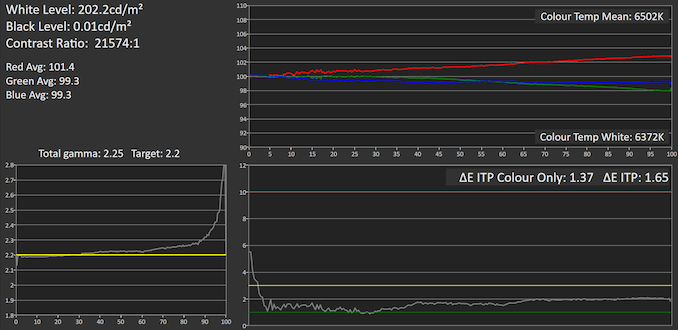
 Portrait Displays CalMAN
Portrait Displays CalMAN
iPhone 12 Pro
We start off the detailed measurements with the greyscale performance of the iPhone 12 Pro. Generally speaking, there’s very little to criticise the device here as there’s generally an excellent performance. Apple still showcases higher gamma at higher level colours, but that’s only a minor imperfection.
The white balance for whites actually is a tad warmer than it should be with some clearly higher-than-average levels of red. Although the total average white balance over all levels lands in at an excellent 6502K, actual whites land in at 6372K. It’s not an issue, but a little less perfect than we had come to expect from iPhones.
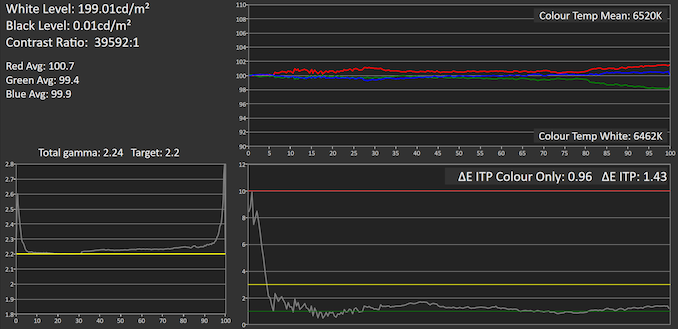
 Portrait Displays CalMAN
Portrait Displays CalMAN
iPhone 12
The iPhone 12 seems to showcase a different calibration than the 12 Pro, further evidence of the two different panels employed on the two models. The 12 seems to have slightly better gamma behaviour on the higher levels, but in exchange showcases worse off gamma at the lower levels, clipping lower level colours to black earlier than on the 12 Pro, which had near perfect behaviour here.
Oddly enough, colour temperature on the 12 behaved better than our 12 Pro sample. Average colour temperature landed in at 6520K while white landed in at 6462K, with less dominant reds than on the other phone.
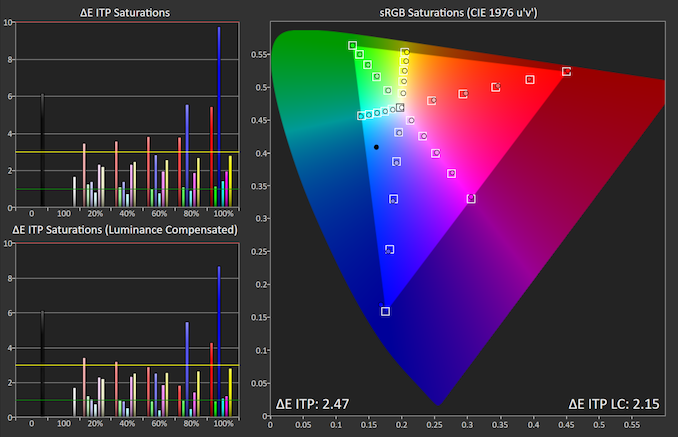 Portrait Displays CalMAN
Portrait Displays CalMAN
iPhone 12 Pro
sRGB colour saturations on the iPhone 12 Pro are quite excellent, with the biggest error margin happening at maximum saturation blues and magentas, with also a slightly oversaturated red. Below maximum intensity, the colours are all showcasing dEITP errors below 3 which is the just perceivable threshold for the average eye.
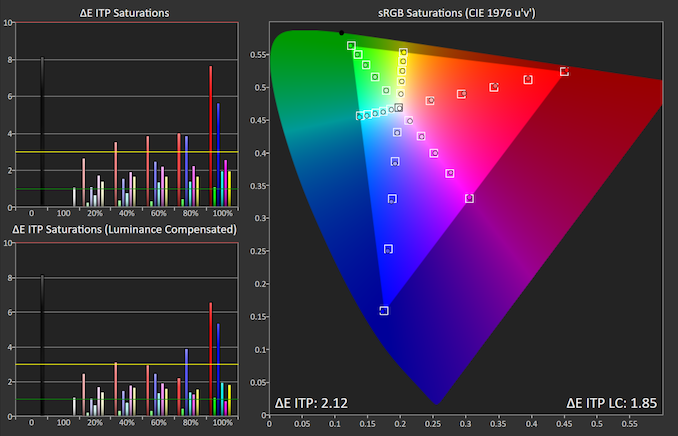 Portrait Displays CalMAN
Portrait Displays CalMAN
iPhone 12
The iPhone 12 has slightly better results, with the blue and magenta error being less pronounced on this phone. Generally it looks that our sample here is again performing a little better than our 12 Pro sample.

 Portrait Displays CalMAN
Portrait Displays CalMAN
iPhone 12 Pro
In our GMB chart with common colours such as skin tones, the iPhone 12 Pro behaves admirably. Given the phone’s inaccuracies seemed to be more prevalent in higher saturations in the blue and red spectrum, and this test doesn’t contain patches in that region of the gamut, it means that the remaining test colours perform extremely well.
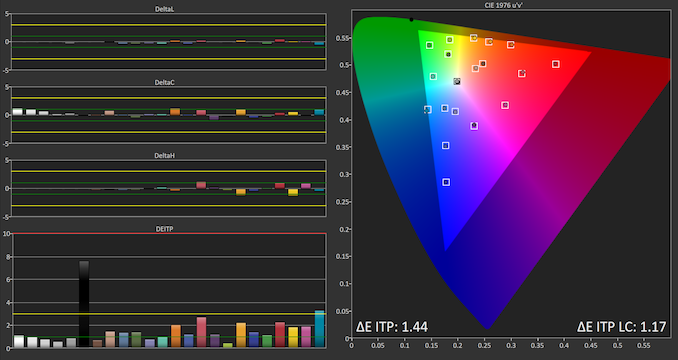
 Portrait Displays CalMAN
Portrait Displays CalMAN
iPhone 12
The iPhone 12 generally seems to beat the iPhone 12 Pro in terms of accuracy, again showcasing better results and an outstandingly good overall error result of dEITP of 1.44.
Apple Typical Best Displays
Overall, the new iPhone 12 series continues Apple’s tradition of having amongst the best calibrated displays on the market. The 12 Pro seems to just shy away from the usual Apple perfection, but the results are still outstandingly good and beyond that of any other device.
I think what’s most important for this generation of devices is the fact that the iPhone 12 now features a higher resolution OLED screen. It can’t be understated how much of an upgrade this is compared to the “Retina” grade LCD panel of the iPhone 11. Personally, this makes the iPhone 12 an actual consideration whereas I wouldn’t have been satisfied with using the iPhone 11’s LCD. It also vastly diminishes the feature gap to the Pro models – I don’t consider the brightness advantage of the 12 Pro to be all that significant, although again the Pro model does showcase better viewing angles and a more pronounced “sticker feel”.










101 Comments
View All Comments
raemike - Monday, November 30, 2020 - link
Apple markets this as the strongest iPhone ever, this is pure BS. The back glass on my iphone12 broke in 3 days. I was putting on boots and the phone fell about 18 inches to a concrete floor. Unbelievable. Apple wants me to pay $100 to fix!!!! The fact is that the iPhone 12, from my experience, is by FAR the most fragile iPhone I've ever owned. Very unhappy that Apple won't even fix their defect. Phone didn't last 3 full days!Holliday75 - Monday, November 30, 2020 - link
You dropped it on concrete ad you blame Apple? LOL.I shot my dog....its the guns fault. I ran a little old lady over. It's the car's fault.
AshlayW - Monday, November 30, 2020 - link
Why did you shoot your dog? Also, you're probably going to prison now.PickUrPoison - Saturday, December 12, 2020 - link
Don’t you care about the little old lady?!?cha0z_ - Tuesday, December 1, 2020 - link
They strictly clarify it's for the FRONT glass, most likely they saved upgrading the back glass for the next year model + glass is glass, no matter how strong it is, the wrong angle/force and you are done.29a - Tuesday, December 1, 2020 - link
What is unbelievable is you didn't have any protection on your phone and now you're bitching about breaking it.techconc - Monday, December 7, 2020 - link
"The back glass on my iphone12 broke in 3 days."If anything, that shows you how strong the ceramic shield is, since only the front of the phone has the ceramic shield.
zanon - Monday, November 30, 2020 - link
Thanks for the review! I upgraded from an iPhone X to the 12 Pro Max this time around, and have been kicking the tires for a week and a half or so now. SO wanted a 12 Pro regular, and a friend got the plain 12. These days I think the additive improvements over 3-5 generations is probably how must people view these things, year-over-year upgrades, or even every 2 years, seems to quite reasonably be less common (which is a good thing). Coming directly from an X, the changes are quite significant. There are obvious sticker items like improved performance and cameras. But there is also more subtle yet extreme important day-to-day use stuff like the Face ID system being a lot more responsive and accepting more angles and distances now then the generation 1 I had before. Some other disagreement, agreement, and comment:Disagreement: I think you really missed the mark on how big a deal the new LIDAR sensor is for pro usage (you barely gave it a sentence) and in turn as a differentiator. In fact even though it's early days and rough, I think that might be one of the most significant Pro differentiators in a long time, "pro" here as-in actual contracting to make money. I've been trying it out with magicplan and RoomScanLiDAR and already used it at a project site. Apps like magicplan previously could be paired with bluetooth laser rangers and used that way (and still can of course), but from my testing so far the new built-in lidar does an extremely close and competent job in measuring over shorter distances and details, and you get a pretty passable v1 3D point cloud too for something you get in your pocket all the time for a few hundred extra. I was able to throw together for plans and basic 3D from scratch for a historic hotel and then use that for mockups and renovation deployment way, way better than I'd ever have expected even a year ago from a handheld with this pricing (dedicated laser 3D scan units have been available for a while, and will produce better results more quickly, but are NOT cheap or pocketable). Even the simple AR Measure app suddenly no longer feels gimicky or last resort but actually is usable without my measuring tape in many cases. The whole calibration thing is gone, it's fast, and accurate in my use to at least 1/2" which for bulk is often good enough.
Again definitely early, early days. There are obvious holes in the apps, basic things like import are non-existent, etc etc. Yet even so it's already saved me some money and time in commercial work. As far as professional usage goes, it feels like a bigger leap forward in terms of the phone itself being a tool (vs an interface to other tools) than many things before.
Agreement: I'm glad you highlighted that the new sharp edges are a definite step back in ergonomics. It was what struck me most immediately of course in terms of out-of-box experience. Maybe it works well for the Mini, but even on the regular (let alone the Max) the hand feel stinks compared to the iPhone X/XS/11. The edges really dig in and add to fatigue.
However, some of that can be mitigated with a case, and that leads me to the comment that I strong suspect Apple is now designing the iPhone at least in part around case use. It's been a while since I last looked it up, but in a previous discussion we did some research and it looked like at least 75% (yes, 3/4) of phone users use cases. They're a big source of personalization, not just in terms of looks but adapting the phone to various personal use cases. Obviously drop/scratch protection to a customizable degree depending on whether someone tends to have accidents or works/hobbies in heavier duty environments, but also more exotic stuff like camera lens/telescope attachment (or just plain extra battery).
That being the case (harhar), there a reasons to design the phone with that in mind. The camera bump for example, they extra z-distance is necessitated by the camera modules. But of course Apple could just make the whole phone thicker so that it was still smooth. And if it was expected the phone would be used bare, that'd make sense. But if it's expected it'll usually be in a case, it makes *more* sense to have it as it is now, because the available mm means the end result is something that provides whatever else the owner wants but being thinner, lighter and flush on the back than if it was a case over an already thickened device.
As someone who has never dropped their expensive handheld stuff in 30 someodd years now and previously never bothered with a case, I do kind of miss good old naked devices. But I can't argue with the numbers either. And for the first time with the 12 I feel like a case is a requirement, not just a nice-to-have, it's too sharp and too slippery without it. Of course this makes the use of steel in the Pro even dumber, extra weight for absolutely nothing. I wonder why Apple didn't use titanium instead, they used to do a lot with that material and it seems like it'd let them claim a different "pro" material without so much weight. Oh well.
Incidentally I think the Max might be the least popular model this time around. I was lazy about ordering, didn't bother for a few days. Yet it shipped almost instantly, while I know people who ordered regular 12s/12 Pros much more quickly than me (same channel/phone company) who are still waiting. Would be interesting if Apple breaks things out, the Mini and regular are really compelling this time (which is as it should be!).
Thanks again for the review.
zanon - Monday, November 30, 2020 - link
Also to add: CreateML (https://developer.apple.com/documentation/createml... is starting to get really impressive, and that Apple has been expending effort to allow it to all stay local rather than dependent on cloud services is useful too. Given the review points out the minimal GPU improvements, it seems like there a implications worth considering given that Apple has chosen to spend a lot of silicon budget on specialized stuff, NN etc instead. At some point I'd like to see more bench marks and articles investigating how that stuff is getting used (even basic simple first party stuff like photo facial recognition), the performance, and what kinds of network dependency and privacy the various iOS/macOS/Android/Windows/Linux implementations have. It's going to be more challenging to to see where silicon budget is yielding gains, but some of that may ultimately matter more than raw CPU/GPU in a lot of day to day and application specific use.name99 - Monday, November 30, 2020 - link
It's always difficult to know just how much of Apple's timing is planned and how much is luck.I think it's definitely planned that the MAC's this year have the same appearance as always, to reassure most buyers that while techies might get excited about the new internals, this is the same familiar mac as always.
BUT I think it's also clear that the CPU/SoC this year had a very different set of priorities from performance, that it was basically more of the same. Changed where that was easy to do given the new process characteristics, but the emphasis on the stuff required for the mac, secondarily on peak power. I raise this because the corollary to the point I made above is that the best time to change the appearance is precisely when the internals are undergoing their least exciting change...
If I had to guess, my guess would be that Apple has established the line (mini, maybe refreshed every two years; mainstream; pro; pro max) and the design language, for the next four years or so. Get used to these sizes and the squared off edges!
On the flip side the most essential Mac-relevant SoC changes are done. Next year may again be "disappointing" in that the leading edge team will have the many core high end machines as its priority, so while the A15 SoC won't exactly be phoned in, it may still be less than we might hope.
On the other hand, as soon as the A16 Apple may be willing to say "OK, Rosetta2 is over for new machines. If a vendor hasn't ported by now, it's not worth our time to keep coddling them". Being able to drop the compatibility stuff [memory ordering, 4kB subpages] will help a bit (less complexity always helps some), and they'll finally be past the huge effort of the transition, so once again performance can get top billing.
Another data point for my theory (this is the appearance for the next four years or so), when do we get an Apple modem? Maybe 2022? Once again that will come in a shell that looks absolutely familiar, like an iPhone has looked for years, so that the fact of getting new technology that the techies are all chattering about won't seem strange and unnerving; what you buy will feel like last year's iPhone.